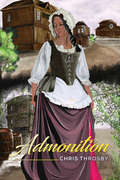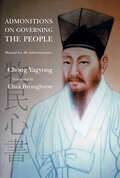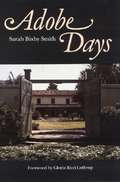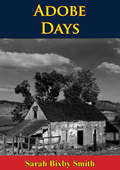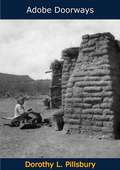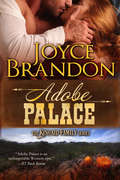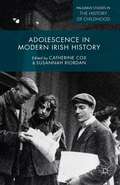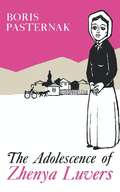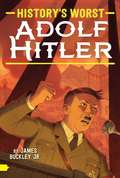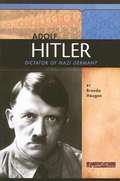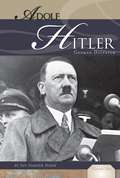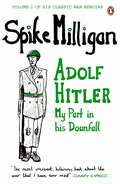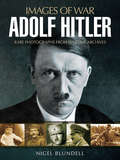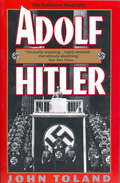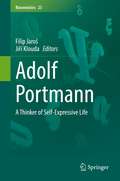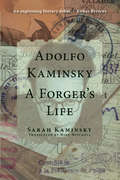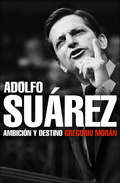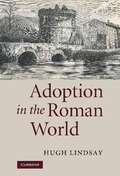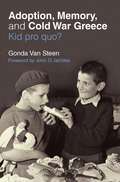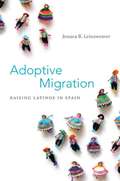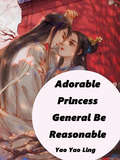- Table View
- List View
Admonition
by Chris ThrosbyBorn in the late 1700s, Admonition's mother has already made her believe her name carries a curse. When her home - along with most of her family - is swallowed by a sink hole, she is taken in by neighbours who provide her with a loving home. She is only 13 when things start to change. By the time she reaches 15, the curse is confirmed, when she is forced to leave by the sexual advances of the man who had initially taken her - a confirmation that is repeated many times in her life. Finding a home with Jabez, the landlord of The Boar's Head, she becomes embroiled in salt smuggling that leads ultimately to transportation and a new life in Australia where she finally finds true love and freedom. As Admonition says at the end of her story, 'Now, I wish there was a way I could tell her what's taken me a lifetime, not to mention a journey to the other side of the world, to learn: we can be unlucky, unfortunate, even oppressed by our circumstances or by those around us, but we are never affected by curses and certainly not by our name - unless of course we choose to believe it.'
Admonitions on Governing the People: Manual for All Administrators
by Yagyong ChongThis is the first English translation of one of Korea’s most celebrated historical works, a pre-modern classic so well known to Koreans that it has inspired contemporary literature and television. Written in 1821 by Chong Yagyong (Tasan), Admonitions on Governing the People (Mongmin simso) is a detailed manual for district magistrates on how to govern better. In encyclopedic fashion, Chong Yagyong addresses the administration, social and economic life, criminal justice, the military, and the Confucian ritual system. He provides examples of past corrupt officials and discusses topics of the day such as famine relief and social welfare. A general call for overhauling the Korean ruling system, the book also makes the radical proposition that the purpose of government is to serve the interests of the people. This long-awaited translation opens a new window on early-nineteenth century Korea and makes available to a wide audience a work whose main concerns simultaneously transcend national and cultural boundaries.
Adobe Days
by Sarah Bixby SmithIn this rollicking reminiscence Sarah Bixby Smith tells of Los Angeles when it was "a little frontier town" and "Bunker Hill Avenue was the end of the settlement, a row of scattered houses along the ridge." She came there in 1878 at the age of seven from the San Justo Rancho in Monterey County. Sarah recalls daily life in town and at San Justo and neighboring ranches in the bygone era of the adobes. Exerting a strong pull on her imagination, as it will on the reader's, is the story of how her family drove sheep and cattle from Illinois to the Pacific Coast in the 1850s. The daughter of a pioneering woolgrower, Sarah Bixby Smith became a leading citizen of California.
Adobe Days: Being The Truthful Narrative Of The Events In The Life Of A California Girl On A Sheep Ranch (large Print Edition)
by Sarah Bixby Smith"In this rollicking reminiscence Sarah Bixby Smith tells of Los Angeles when it was "a little frontier town" and "Bunker Hill Avenue was the end of the settlement, a row of scattered houses along the ridge." She came there in 1878 at the age of seven from the San Justo Rancho in Monterey County. Sarah recalls daily life in town and at San Justo and neighboring ranches in the bygone era of the adobes. Exerting a strong pull on her imagination, as it will on the reader's, is the story of how her family drove sheep and cattle from Illinois to the Pacific Coast in the 1850s. The daughter of a pioneering woolgrower, Sarah Bixby Smith became a leading citizen of California."-Print ed.
Adobe Doorways
by Dorothy L. PillsburyFollowing on from the first in this series, No High Adobe, which was published in 1950, in this 1952 follow-up, Adobe Doorways, author Dorothy L. Pillsbury takes the reader on a journey into the heart—and often the soul—of Northern New Mexico. We visit Teronrio Flat, as well as friends in the Indian Pueblos and Spanish-American villages in the mountains.As with No High Adobe, this exuberant collection of thirty-six tales emanate from the author’s deep experience of the land and its people, conveying the spirit of both with the care of a loving friends and the skill of a talented storyteller.
Adobe Palace: The Kincaid Family Series - Book Four (The Kincaid Family Series #4)
by Joyce BrandonThis “unforgettable Western epic” from the author of Lady and the Lawman is “a superb achievement as both a saga and a romance” (RT Book review, 4 Stars). Arizona Territory, 1889. After her parents died at sea, little Samantha Forrester came to live with the Kincaid family . . . and strapping young Lance Kincaid became her adored protector. Years later, when Lance married another woman, Samantha tried to forget him by marrying his friend Jared. But Jared wasn’t Lance. When he died, he left Samantha a single mother, still heartsick for another woman’s husband. Then the devilishly charming Steve Sheridan rides into Samantha’s life. Suddenly she sees her chance to build the house of her dreams, save her son’s life, and claim Lance’s heart for her own. But life doesn’t always go according to plan, and fate will take them all on a journey as wild as the land they live on.
Adolescence in Modern Irish History: Innocence And Experience (Palgrave Studies in the History of Childhood)
by Catherine Cox Susannah RiordanThis edited collection is the first to address the topic of adolescence in Irish history. It brings together established and emerging scholars to examine the experience of Irish young adults from the 'affective revolution' of the early nineteenth century to the emergence of the teenager in the 1960s.
Adolescence of Zhenya Luvers
by Boris PasternakAn enthralling novelette by Boris Pasternak, the author of Dr. Zhivago, Adolescence of Zhenya Luvers explores how a thirteen-year-old girl ceases to be a child and becomes a woman in Russia just before the Communist Revolution. The story examines the world through the reminiscences of a young girl and explores such themes as nature and how we are able to shape the world around us by how we perceive it. The novelette gives readers a prime example of Pasternak’s signature style and use of poetics, imagery, and lyricism in prose. Adolescence of Zhenya Luvers is one of Pasternak’s first stories, and it originally appeared in a collection by the same name published in 1925. Author: Boris (Leonidovich) Pasternak was a Russian philosopher, poet, writer, and translator. He is famous worldwide for his novel Doctor Zhivago, which won him the Nobel Prize in Literature in 1958. Born in Moscow in 1890 to a painter father and concert-pianist mother, Pasternak first pursued a formal education in musical composition at the University of Moscow, studying under the composer Scriabin. After six years, he gave up music and, following a brief stint in Germany studying philosophy, he returned to Russia to devote his life to writing. With the release of two major works of poetry—My Sister Life (1922) and Themes and Variations (1923), Pasternak found himself among the leading poets in Russia. He went on to publish works of fiction, including Adolescence of Zhenya Luvers (1924), several short story collections, and an acclaimed autobiography. As his writing grew more political in the ’30s and ’40s, Pasternak was unable to publish his own poetry, and instead turned to translating great literary works, including his mentor Rainer Marie Rilke, into Russian. In 1957, only three years before his death, he published Doctor Zhivago to instant international acclaim and a Nobel Prize nomination. In Russia, however, the book’s politics were not well received. It was banned and Pasternak was expelled from the Union of Soviet Writers. This tumultuous political spotlight forced him to decline the award. Since his death in 1960, however, Pasternak’s works have grown in popularity and he remains one of the most influential Russian writers of the twentieth century.
Adolf Hitler
by James Buckley Jr.Get a behind-the-scenes glimpse of what it takes to be considered one of the worst figures in history, with this brand-new nonfiction series that focuses on the most nefarious historical figures.On a list of the worst people ever, Adolf Hitler is certainly at or near the top. Born the son of a low-ranking government official, no one would have predicted that the young Adolf would grow up and become the leader of millions of Germans as well as one of the most despised figures of the twentieth century. Hitler himself wanted to be an artist, but he couldn’t get into art school. The rejection was just one more thing in a long chain of events that made him angry. Angry at the world. Angry at specific groups of people. As his anger grew, so did his hatred until eventually there was very little else left. When Hitler entered politics, he found himself surrounded by people who agreed with him. Who would listen to his rants and would happily follow his every decree and cheer his every word. But why did people let him do that? Why did they follow him? What made his policies so attractive? And what made Adolf Hitler so popular? Find out with this biography that takes a deeper look at Hitler…because history isn’t just about the heroes.
Adolf Hitler: A Biographical Companion
by David NichollsAn encyclopedia of topics relating to the German leader such as his most important collaborators and opponents, his domestic and foreign policies, the use of propaganda and the forging of the Hitler cult, racial persecution and the Holocaust, and Hitler as a war leader. Each entry cites related entries and suggests further reading. Further support includes a historical introduction, excerpts from documents, and a chronology. No credentials are noted for Nicholls.
Adolf Hitler: Dictator of Nazi Germany
by Brenda HaugenA biography profiling the life of Adolf Hitler, the dictator of Nazi Germany. Includes source notes and timeline.
Adolf Hitler: German Dictator
by Sue Vander HookPresents the life of the German dictator who conquered most of Europe and carried out the murders of over eleven million people during the Holocaust.
Adolf Hitler: My Part in his Downfall (Spike Milligan War Memoirs)
by Spike MilliganVolume one of Spike Milligan's legendary memoirs is a hilarious, subversive first-hand account of WW2'The most irreverent, hilarious book about the war that I have ever read' Sunday Express'Close in stature to Lewis Carroll and Edward Lear in his command of the profound art of nonsense' Guardian______________'At Victoria station the R.T.O. gave me a travel warrant, a white feather and a picture of Hitler marked "This is your enemy". I searched every compartment, but he wasn't on the train . . .' In this, the first of Spike Milligan's uproarious recollections of life in the army, our hero takes us from the outbreak of war in 1939 ('it must have been something we said'), through his attempts to avoid enlistment ('time for my appendicitis, I thought') and his gunner training in Bexhill ('There was one drawback. No ammunition') to the landing at Algiers in 1943 ('I closed my eyes and faced the sun. I fell down a hatchway'). Filled with bathos, pathos and gales of ribald laughter, this is a barely sane helping of military goonery and superlative Milliganese.______________ 'That absolutely glorious way of looking at things differently. A great man' Stephen Fry'Milligan is the Great God to all of us' John Cleese 'The Godfather of Alternative Comedy' Eddie Izzard 'Manifestly a genius, a comic surrealist genius and had no equal' Terry Wogan 'A totally original comedy writer' Michael Palin
Adolf Hitler: Rare Photographs from Wartime Archives (Images of War)
by Nigel BlundellA rare, revealing, and chilling photographic history of Adolf Hitler—from mollycoddled child to vile propagandist to despotic madman. One of the most intriguing mysteries about the rise of history&’s most despised dictator is just how utterly ordinary he once seemed. A chubby child, a mama&’s boy, an idle student, a failed artist, self-pitying outcast, and just another face in the crowd. The early images of Adolf Hitler give no hint of the demonic spirit bent on global domination. Only later in his tortured life came the metamorphosis, and the mask fell away to reveal a monster. Adolf Hitler: Rare Photographs from Wartime Archives traces this dramatic process in photographs—some iconic, some rare and intimate. And they are all revealing in their gradually subtle and disturbing transformation, demonstrating the mesmerizing power that Hitler wielded not only over the German public but also statesmen, industrialists, and the global media. Many culled from the author&’s private collection, the photographs collected here provide unique insight into the mind of a megalomaniac and architect of the twentieth century&’s most unfathomable atrocity.
Adolf Hitler: The Definitive Biography
by John TolandPulitzer Prize-winning historian John Toland's classic, definitive biography of Adolf Hitler remains the most thorough, readable, accessible, and, as much as possible, objective account of the life of a man whose evil affect on the world in the twentieth century will always be felt.Toland's research provided one of the final opportunities for a historian to conduct personal interviews with over two hundred individuals intimately associated with Hitler. At a certain distance yet still with access to many of the people who enabled and who opposed the führer and his Third Reich, Toland strove to treat this life as if Hitler lived and died a hundred years before instead of within his own memory. From childhood and obscurity to his desperate end, Adolf Hitler emerges , in Toland's words, "far more complex and contradictory . . . obsessed by his dream of cleansing Europe Jews . . . a hybrid of Prometheus and Lucifer."
Adolf Portmann: A Thinker of Self-Expressive Life (Biosemiotics #23)
by Filip Jaroš Jiří KloudaThis edited volume is the first specialized book in English about the Swiss zoologist and anthropologist Adolf Portmann (1897-1982). It provides a clarification and update of Portmann’s theoretical approach to the phenomenon of life, characterized by terms such as “inwardness” and “self-presentation.” Portmann’s concepts of secondary altriciality and the social uterus have become foundational in philosophical anthropology, providing a benchmark of the difference between humans and animals. In its content, this book brings together two approaches: historical and philosophical analysis of Portmann’s studies in the life sciences and application of Portmann’s thought in the fields of biology, anthropology, and biosemiotics. Significant attention is also paid to the methodological implications of his intended reform of biology. Besides contributions from contemporary biologists, philosophers, and historians of science, this volume also includes a translation of an original essay by Portmann and a previously unpublished manuscript from his most remarkable English-speaking interpreter, philosopher Marjorie Grene. Portmann’s conception of life is unique in its focus on the phenomenal appearance of organisms. Confronted with the enormous amount of scientific knowledge being produced today, it is even clearer than it was during Portmann’s lifetime that although biologists employ physical and chemical methods, biology itself is not (only) physics and chemistry. These exact methods must be applied according to what has meaning for living beings. If biology seeks to understand organisms as autonomous agents, it needs to take display and the interpretation of appearances as basic characteristics of life. The topic of this book is significantly relevant to the disciplines of theoretical biology, philosophy, philosophical anthropology, and biosemiotics. The recent epigenetic turn in biology, acknowledging the interconnections between organismal development, morphology and communication, presents an opportunity to revisit Portmann’s work and to reconsider and update his primary ideas in the contemporary context.
Adolfo Kaminsky: A Forger's Life
by Mike Mitchell Adolfo Kaminsky Sarah Kaminsky[An] engrossing literary debut. ... Writing in Adolfo's voice gives this suspenseful narrative candor and immediacy.- Kirkus ReviewsAdolfo Kaminsky: A Forger's Life is "worthy of the best spy novels" and tells the story of Sarah Kaminsky's father, "the genius-forger who committed his know-how and convictions to serve the French Resistance during World War II, saving thousands of Jewish families, and many others over the course of 30 years for various causes around the world."- TED.comA detailed and touching story traversing a century in clandestine shadow crossings, where Adolfo's skill meant life... or death.- Libération, FranceRiveting.- Haaretz, IsraelTechnical prowess, creativity, and self-denial drive the plot in the incredibly lucky life of Adolfo Kaminsky narrated in this exciting historical document.- Elle Magazine, France; 2010 Reader's Choice AwardUndoubtedly one of the most captivating books of the season.- Paris TodayA pointed, sober biography ... of one of the world's best forgers.- Der SpiegelIf made into a film, the life of Adolfo Kaminsky would have the ingredients of suspense thriller, war movie, historical tragedy, intimate drama, romantic comedy and scenes of terror.- O Globo, BrazilA thrilling book.- la Repubblica Federal, ItalyKaminsky has lived, in the shadows, the brightest hours of the Resistance.- Le MondeBest-selling author Sarah Kaminsky takes readers through her father Adolfo Kaminsky's perilous and clandestine career as a real-life forger for the French Resistance, the FLN, and numerous other freedom movements of the twentieth century. Recruited as a young Jewish teenager for his knowledge of dyes, Kaminsky became the primary forger for the French Resistance during the Nazi occupation of Paris. Then, as a professional photographer, Kaminsky spent the next twenty-five years clandestinely producing thousands of counterfeit documents for immigrants, exiles, underground political operatives, and pacifists across the globe. Kaminsky kept his past cloaked in secrecy well into his eighties, until his daughter convinced him to share the details of the life-threatening work he did on behalf of people fighting for justice and peace throughout the world."It took me two years of research and some twenty interviews before I got to know Adolfo Kaminsky, who I only knew as 'Papa': decoding his silences, detecting between the notes of his monotone delivery things he didn't put into words, understanding the parables and finding the messages hidden beneath the series of anecdotes that filled my notebook. And sometimes I needed to see the way other people looked at him to understand his choices, his life as a forger, his work underground, his political commitments, his inability to understand society and the hatred motivating various groups that encumbered it, his desire to build a world of justice and freedom." -Sarah Kaminsky, Prologue
Adolfo Suárez: Ambición y destino
by Gregorio MoránLa obra definitiva sobre Adolfo Suárez, el primer presidente de la democracia, con todas sus luces y todas sus sombras. Nombrado por sorpresa presidente de un gobierno autoritario en julio de 1976 y dimitido también por sorpresa como presidente de una democracia en enero de 1981, la trayectoria personal y política de Adolfo Suárez quizá simbolice mejor que ninguna otra lo que fue la España de las postrimerías del franquismo y la transición. Odiado hasta lo patológico por muchos durante su apogeo, y con el tiempo ensalzado por la mayoría, Suárez es sin duda una pieza clave en la construcción de la democracia. En esta extraordinaria biografía, Gregorio Morán, autor de un primer y polémico libro sobre Suárez en 1979, revisita al personaje no solo para contarnos el resto de su trayectoria, hasta la ya famosa foto con el Rey el 18 de julio de 2008, sino también reevaluar, a la luz de la España de hoy, un periodo fundamental de nuestra historia reciente. Reseña:«El perfil más cercano y verídico de un hombre que ya es historia viva de este país.»Cambio 16
Adolph Rupp and the Rise of Kentucky Basketball
by James Duane BolinAn in-depth look at the life of the influential University of Kentucky basketball coach and his legacy.Known as the “Man in the Brown Suit” and the “Baron of the Bluegrass,” Adolph Rupp (1901–1977) is a towering figure in the history of college athletics. In Adolph Rupp and the Rise of Kentucky Basketball, historian James Duane Bolin goes beyond the wins and losses to present the fullest account of Rupp’s life to date based on more than one-hundred interviews with Rupp, his assistant coaches, former players, University of Kentucky presidents and faculty members, and his admirers and critics, as well as court transcripts, newspaper accounts, and other archival materials. His teams won four NCAA championships (1948, 1949, 1951, and 1958), the 1946 National Invitation Tournament title, and twenty-seven Southeastern Conference regular season titles. Rupp’s influence on the game of college basketball and his impact on Kentucky culture are both much broader than his impressive record on the court.Bolin covers Rupp’s early years?from his rural upbringing in a German Mennonite family in Halstead, Kansas, through his undergraduate years at the University of Kansas playing on teams coached by Phog Allen and taking classes with James Naismith, the inventor of basketball?to his success at Kentucky. This revealing portrait of a pivotal figure in American sports also exposes how college basketball changed, for better or worse, in the twentieth century.Praise for Adolph Rupp and the Rise of Kentucky Basketball“This detailed and richly researched biography is written in a clear and engaging manner that reflects the work of a historian at the top of his game. Bolin is definitely fully engaged with Adolph Rupp’s multi-faceted life and has demonstrated his mastery of his wide-ranging sources. An excellent book!” —Richard O. Davies, Distinguished Profess or History, Emeritus, University of Nevada, Reno“An incisive analysis of Adolph Rupp’s role in creating the Big Blue Nation . . . . An unvarnished and well-sourced examination of a flawed human being . . . . A must-read for any true Kentucky fan.” —Roberta Schultz, WVXU Radio Cincinnati
Adopted Son: Washington, Lafayette, and the Friendship That Saved The Revolution
by David A. ClaryThey were unlikely comrades-in-arms. One was a self-taught, middle-aged Virginia planter in charge of a ragtag army of revolutionaries, the other a rich, glory-seeking teenage French aristocrat. But the childless Washington and the orphaned Lafayette forged a bond between them as strong as any between father and son. It was an unbreakable trust that saw them through betrayals, shifting political alliances, and the trials of war. Lafayette came to America a rebellious youth whose defiance of his king made him a celebrity in France. His money and connections attracted the favor of the Continental Congress, which advised Washington to keep the exuberant Marquis from getting himself killed. But when the boy-general was wounded in his first battle, he became a hero of two countries. As the war ground on, Washington found in his young charge the makings of a courageous and talented commander whose loyalty, generosity, and eagerness to please his Commander in Chief made him one of the war's most effective and inspired generals. Lafayette's hounding of Cornwallis's army was the perfect demonstration of Washington's unconventional "bush-fighting" tactics, and led to the British surrender at Yorktown. Their friendship continued throughout their lives. Lafayette inspired widespread French support for a struggling young America and personally influenced Washington's antislavery views. Washington's enduring example as general and statesman guided Lafayette during France's own revolution years later. Using personal letters and other key historical documents, Adopted Son offers a rare glimpse of the American Revolution through the friendship between Washington and Lafayette. It offers dramatic accounts of battles and intimate portraits of such major figures as Alexander Hamilton, Benedict Arnold, and Benjamin Franklin. The result is a remarkable, little-known epic of friendship, revolution, and the birth of a nation. From the Hardcover edition.
Adoption in the Roman World
by Hugh LindsayAdoption in other cultures and other times provides a background to understanding the operation of adoption in the Roman worlds. This book considers the relationship of adoption to kinship structures in the Greek and Roman world. It considers the procedures for adoption followed by a separate analysis of testamentary cases, and the impact of adoption on nomenclature. The impact of adoption on inheritance arrangements is considered, including an account of how the families of freedmen were affected. Its use as a mode of succession at Rome is detailed, and this helps to understand the anxiety of childless Romans to procure a son through adoption, rather than simply to nominate heirs in their wills. The strategy also had political uses, and importantly it was used to rearrange natural succession in the imperial family. The book concludes with political adoptions, looking at the detailed case studies of Clodius and Octavian.
Adoption, Memory, and Cold War Greece: Kid pro quo?
by Gonda Van SteenThis book presents a committed quest to unravel and document the postwar adoption networks that placed more than 3,000 Greek children in the United States, in a movement accelerated by the aftermath of the Greek Civil War and by the new conditions of the global Cold War. Greek-to-American adoptions and, regrettably, also their transactions and transgressions, provided the blueprint for the first large-scale international adoptions, well before these became a mass phenomenon typically associated with Asian children. The story of these Greek postwar and Cold War adoptions, whose procedures ranged from legal to highly irregular, has never been told or analyzed before. Adoption, Memory, and Cold War Greece answers the important questions: How did these adoptions from Greece happen? Was there any money involved? Humanitarian rescue or kid pro quo? Or both? With sympathy and perseverance, Gonda Van Steen has filled a decades-long gap in our understanding, and provided essential information to the hundreds of adoptees and their descendants whose lives are still affected today.
Adoptive Migration: Raising Latinos in Spain
by Jessaca B. LeinaweaverSpain has one of the highest per capita international adoption rates in the world. Internationally adopted kids are coming from many of the same countries as do the many immigrants who are radically transforming Spain's demographics. Based on interviews with adoptive families, migrant families, and adoption professionals, Jessaca B. Leinaweaver examines the experiences of Latin American children adopted into a rapidly multiculturalizing society. She focuses on Peruvian adoptees and immigrants in Madrid, but her conclusions apply more broadly, to any pairing of adoptees and migrants from the same country. Leinaweaver finds that international adoption, particularly in a context of high rates of transnational migration, is best understood as both a privileged and unusual form of migration, and a crucial and contested method of family formation. Adoptive Migration is a fascinating study of the implications for adopted children of growing up in a country that discriminates against their fellow immigrants.
Adorable Princess: Volume 1 (Volume 1 #1)
by Yao YaoLingIt was well-known that Mo Mansion's direct daughter, Mo Ran, was arrogant and unreasonable.Once she transmigrated, she became the Mo Estate's direct daughter.With the virtue of my heart, I saved a man who was seriously injured, but I was caught by him.He couldn't chase them away, and he couldn't beat them either. He had to prevent them from being found out at all times.After leaving the capital for five years, Mo Yeyue, who had returned to the capital, discovered that not only did Mo Yanxue not turn crooked after not seeing him for a few years, he had become even more exquisite and more lively.With the virtue of being like a fertile river that didn't flow to a foreign land, Mo Yanxue decided to accept this little monster. It was enough to harm him by himself.

